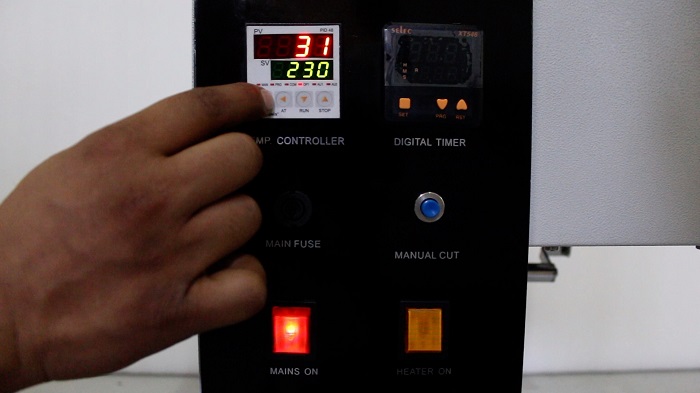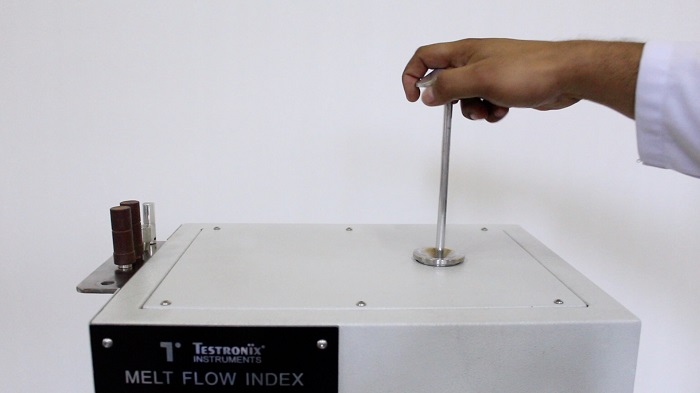Reviewed by Anurag Mishra (Sr. Technical Consultant)

This test entails key information about the behavior of thermoplastics under certain temperature and pressure conditions. It provides manufacturers with critical information to optimize production processes and ensure product consistency.
Evaluation of processability: A melt flow tester allows quantitative measurement of the flow of a polymer during processing. This helps manufacturers to predict how easily material will flow through processing equipment, ensuring uniformity across production stages.
Quality Control: The melt index tester is an integral part of quality assurance processes that allow manufacturers to check the consistency of polymer batches and ensure that they meet specified flow requirements. Deviations in MFI values ??may indicate differences in polymer composition, molecular weight, or processing conditions.
Material Selection: Engineers and designers use MFI machine data to select appropriate polymers for specific applications based on their flow properties. Higher MFI values show higher flowability, which may be desirable for complex mold structures or thin-walled parts, while lower MFI values ??indicate more viscous materials.
Product Performance: MFI correlates with other material properties such as tensile strength, and dimensional stability. By understanding the flow behavior of a polymer through MFI testing, manufacturers can predict its performance in service environments and ensure that products meet durability and reliability requirements.
The benefits of utilizing plastic melt flow index tester in polymer research and manufacturing are significant:
Process Optimization: MFI data helps optimize process parameters such as melt temperature, injection pressure, and vibration speed in extraction and polishing processes. These optimizations reduce cycle times and scrap rates, reducing costs and hence improving productivity.
Quality assurance: By establishing MFI guidelines for raw materials and finished products, we can maintain product quality. This consistency reduces churn rates, improves product reliability, and improves customer satisfaction.
Material Description: The MFI test provides a comprehensive understanding of the rheological properties of polymers, aiding material characterization and formulation development. This supports research efforts to develop new materials and materials tailored to specific applications.
Industry Standard Approval: Several international standards organizations, such as ASTM International and ISO, specify MFI test methods for evaluating the flow properties. Compliance with these standards ensures quality, integrity and uniformity.
MFI testing finds wide-ranging applications across various industries and sectors:
Automobile: evaluates the flow characteristics of plastics used in engine parts such as underbody parts to meet performance and safety standards of the industry.
Package: Improves the performance of polymers which are part of producing plastic films, bottles, etc.
Consumer Goods: evaluates the flow of polymers which are essential factors for producing appliances, electronics, and furniture.
Medical Materials: tests the flow properties of polymers used in medical tubing, medical devices, and implants

A1. Higher MFI values indicate greater flowability, whereas lower MFI values suggest higher viscosity and may be preferable for structural components needing strength and dimensional stability. Thus, MFI helps engineers and manufacturers select polymers that align with the performance requirements of specific products, ensuring optimal processing and end-use performance.
A2. Several factors can affect MFI test results, including:
Temperature: Changes in melt temperature can significantly alter polymer viscosity and flow behavior during the test, affecting MFI values. Standardized testing conditions ensure consistent temperature control for accurate comparisons.
Pressure: The applied load or pressure during the MFI test affects the flow rate of molten polymer through the orifice. Higher pressures can result in higher MFI values by promoting greater flowability.

Material Composition: Variations in polymer composition, molecular weight distribution, additives, and fillers can influence MFI values. Manufacturers must ensure uniformity across batches of production.
Testing Features: Adhering to standardized testing protocols, which include the ASTM or ISO standards, is critical to acquiring dependable and reproducible MFI results. Variations in testing equipment, procedures, or environmental situations can affect check outcomes.
In conclusion, Melt Flow Index testing plays a pivotal role in evaluating the flow properties and processability of thermoplastic polymers across diverse industrial applications. By offering quantitative facts, MFI testing permits producers to optimize manufacturing processes, ensure product consistency, and meet stringent standards. As industries continue to innovate and call for high-overall performance substances, MFI remains an essential instrument for boosting product design, production efficiency, and standard competitiveness in the international marketplace. Embracing MFI testing as a part of substance characterization and great manipulation techniques empowers producers to supply robust, reliable, and technologically superior plastic merchandise that meets the evolving wishes of current industries.
Want to know the melt flow index tester price? Do not wait any further and get onto our website for model-wise specifications. Reach out to us through a phone call at +91 9313140140 or directly drop us an e-mail at info@testronixinstruments.com